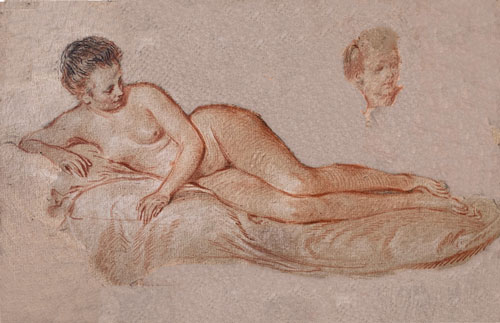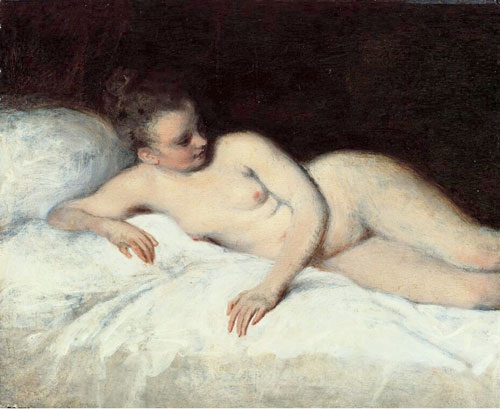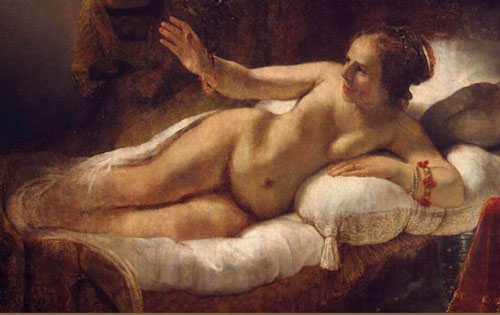
- Home Page
- Accepted
Paintings & Copies - Doubtful
Attributions - Doubtful Textual References
- Alternative
Titles - Collectors &
Museums - Bibliography
- Search Abecedario
- Watteau &
His Circle
Femme nue et couchée
Entered April 2019; revised January 2020
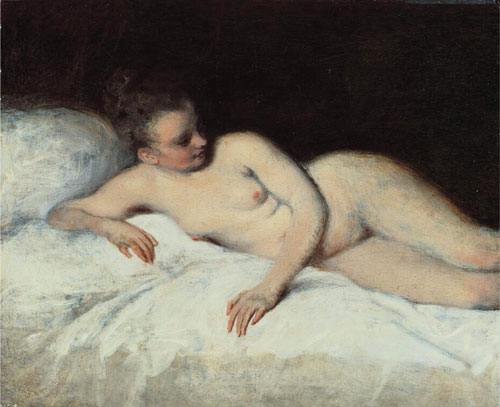
Pasadena, California, Norton Simon Foundation, inv. F.1972.12.P
Oil on panel
15.2 x 17.5 cm.
ALTERNATIVE TITLES
Femme nue étendue
Figure of a Nude Woman
Jeune femme nue couchée
Jeune nue couchée
Лежащая на белой постели обнаженная женщина
Nackte, liegende Frau auf einem Bett
Reclining Nude
Study of a Nude Woman
PROVENANCE
Paris, collection of baron Louis Antoine Crozat de Thiers (1699-1770); cited in Catalogue des Tableaux de M. Crozat, baron de Thiers (1755), 62. Listed in D’Argenville, Voyage pittoresque de Paris (1757), 139; also cited in Vente de tableaux, pastels et dessins des heritiers de M Le Baron et de Madame la baronne de Thiers a L’Imperatrice de Russie, 4 January 1772, cat 358.
St. Petersburg, collection of Catherine II (1729-1796; Empress of Russia); cited in the 1786 Catalogue of Paintings of the Marble Palace, cat. 171.
Given to Prince Grigori Orlov (1734-1783); by descent in the Orlov family.
St. Petersburg and Paris, collection of Prince Alexis Orloff (1867-1916).
Paris, with Richard Owen (1873-1946; dealer); sold to Samuel H. Kress in 1939 for $3,750.
New York, collection of Samuel H. Kress (1863-1955; businessman); given to his mistress, Delora Kilvert, before December 1945.
New York, collection of Delora Kilvert (1891-1961; born Elsie Delora Bernardo).
New York, with Eugene V. Thaw, Inc.; sold May 16, 1972, to The Norton Simon Foundation for $204,000.
EXHIBITIONS
New York, Knoedler and Company, Classics of the Nude (April 10-May 6, 1939), cat. 14 (Watteau, Study of a Nude Woman, lent by Samuel H. Kress, Esq.).
New York, New York World’s Fair, Masterpieces of Art (1939), cat. 408 (Watteau, Figure of a Nude Woman, lent by Samuel H. Kress).
Toronto, Art Gallery of Toronto, An Exhibition of Great Paintings in Aid of the Canadian Red Cross . . . (November-December 1940), cat. 45 (Watteau, Study of a Nude Woman, lent by Samuel H. Kress, Esq.).
San Francisco, California Palace of the Legion of Honor, Three Centuries of French Art (1973), cat. 7 (Watteau, Reclining Nude, lent by the Norton Simon Foundation).
Washington, National Gallery of Art, April 1972-March 1973, on loan.
Princeton, Princeton University Art Museum, c. 1981, on loan.
SELECT BIBLIOGRAPHY
D’Argenville, Voyage Pittoresque de Paris (1758, 3rd edition), 139.
Goncourt, Catalogue raisonné (1875), under cat. 91.Dacier, Vuaflart, and Hérold, Jean de Jullienne et les graveurs (1921-29), 3: under cat. 149, 306.
Mathey, "Watteau, Boucher et le modèle” (1937), 37-39.
Mathey, “Aspects divers de Watteau dessinateur” (1938), 373.
“Classics of the Nude" (1939), 5.
Frankfurter, Masterpieces of Art (1939), 16.
Pach, European & American Paintings (1940), cat. 210.
Shapley, “More Masters at the Fair” (1940), 10.
Adhémar, Watteau (1950), 54 n. 20, cat. 119.
Mathey, Watteau, peintures réapparues (1959), 49, 69, cat. 125.
Stuffman, “Collection Pierre Crozat” (1968), cat. 183.
Montagni and Macchia, Watteau (1969), cat. 135.
Cormack, Drawings of Watteau (1970), under cat. 114.
Ferré, Watteau (1972), 1: 60, 62.
Posner, “Watteau’s Reclining Nude” (1972), 385-88.
Posner, A Lady at Her Toilet (1973), 34-36.
Cailleux, “A Strange Monument” (1975), 246.
Morse, Old Master Paintings in North America (1979), 297.
Hagstrum, Sex and Sensuality (1980), 302-03.
Roland Michel, Watteau (1981), cat. 173.
Posner, Watteau (1984), 102-06.
Roland Michel, Watteau (1984), 220-21.
Washington, Paris, Berlin, Watteau 1684-1721 (1984), under cat. D88.
Börsch-Supan, “Frederick the Great and Watteau” (1984), 553.
Walsh, “Acquisitions 1986” (1987), 197.
Abdo, Masterpieces from the Norton Simon Museum (1989), 88.
Moureau, “Le Tableau libertin" (1993), 99-100.
Rosenberg and Prat, Watteau, catalogue raisonné des dessins (1996), under cat, 486.
Wintermute, Watteau and His World (1999), under cat. 24.
Rosenberg and Prat, Watteau, catalogue raisonné des dessins (1996), under cat. 486.
Temperini, La Peinture française (1999), 1: 416.
Campbell, Collector Without Walls (2010), 342, cat. 819.
Temperini, Watteau (2002), 49, cat. 37.
Glorieux, Watteau (2011), 312-13.
Vogtherr, Französische Gemälde (2011), cat. A2.
Malinovskii, Istoriya kollektsionirovaniya zhivopisi (2012), 458, no. 171.
Nicoud, “Un Manuscrit français” (2015), 57.
RELATED DRAWINGS

Watteau, Femme nue et couchée.
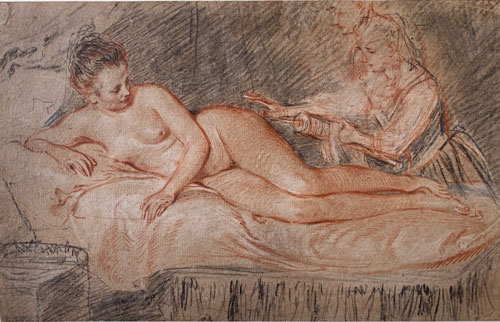
Watteau, Nude Woman Receiving an Enema, red, black, and white chalk, 23.4 x 37.1 cm. Los Angeles, J. Paul Getty Museum.
The Norton Simon painting is closely related to a Watteau compositional drawing also in California, in the Getty Museum (Rosenberg and Pratt 486). The correspondence between the drawing and the painting is remarkable, at least in light of the nude. If the painting had not been cut at the right and her lower legs were included, the relationship would be more marked.
On the other hand, the background of the drawing is extremely problematic. Whereas the nude was drawn in red chalk, and then received vivid accents—black chalk to the hair, white chalk highlights to the body—the background was drawn far less precisely, in a combination of black and red chalk. The sheet is a palimpsest that includes three quickly sketched indications of women. The one at the upper reach of the page evidently extended beyond the edge; it faces the woman. Slightly lower, inclined, and facing toward the right like the nude herself, is a second head. The third and dominant study shows a female attendant, preparing to administer an enema to her lady. It is evident that Watteau drew the recumbent nude first, and these other elements were drawn later and quite specifically do not overlap the nude body. The rapidly drawn hachures do not cover any part of the nude woman.
How are we to interpret the Getty drawing and, equally important, how are we to understand the relation between it and the painting? The first stage of the Getty drawing, as we would reconstruct it, recorded just the nude woman on the bed and, at the right, a secondary study of her head. There are comparable arrangements in other Watteau drawings, such as the study of a standing woman in the Berlin Kupferstichkabinett (Rosenberg and Prat 478 ), and a study in Cleveland for Le Conteur (Rosenberg and Prat R118). Could it be that Watteau drew just this nude as we have proposed, and then painted it just this way, against a plain background and without any servant or accessories, much less a narrative? It remains a strong possibility that Watteau based the Norton Simon panel on the Getty drawing at this stage of its development.
At a later moment—perhaps minutes later, or days or months later—Watteau augmented his drawing. Using red chalk, he lightly drew in the two studies of a servant, and then emphasized the major lines in vigorous stokes of black chalk. With the same black chalk he drew in a curtained background and in the foreground he indicated the drapery folds and a small table or other accessory. After having established this more elaborate, carefully balanced composition, it seems unlikely that he would now have reverted to the simpler scheme seen in the Norton Simon painting. Many Watteau scholars—including Roland-Michel and Glorieux—presumed and still he presume that he painted a servant under the black ground, but x-rays have shown that there is nothing beneath the surface.
After Watteau created the composition registered in the Getty drawing, did he then paint such a scene? Did he paint a picture showing the nude receiving an enema? This is not impossible. Two other Watteau paintings, both of a woman at her toilet, one actually urinating, reveal a side of Watteau’s persona that is too often overlooked.
REMARKS
The history of the Norton Simon painting is fascinating. The small panel was first recorded in the collection of the baron de Thiers, the nephew of Watteau’s patron and friend, Pierre Crozat. A natural tendency would be to conjecture that the latter once owned this charming and intimate scene. It may be a tantalizing possibility but there is no proof.
More remarkable is the generally neglected passage of this painting to Catherine the Great’s collection. It was recorded in the 1772 list of paintings from the de Thiers collection being offered to the Russian empress, and it was subsequently cited in the 1786 inventory of the Marble Palace in St. Petersburg. That palace and its contents were given to Prince Grigori Orlov, the painting either separately or as part of the palace’s content. The 1786 inventory of the Marble Palace records the presence of the Femme nue et couchée. Watteau's painting evidently then descended in the Orlov family and reemerged only in the early twentieth century in the holdings of Prince Alexis Orloff in Paris. This documented provenance disproves Börsch-Supan’s (and Vogtherr’s) theory that the Norton Simon painting may be identified with one seen in Berlin in 1747 of a nude woman and man on a bed; that reference must belong to another and quite different work.
When the Femme nue et couchée was in the baron de Thiers collection, it was measured as 7.5 pouces in height and 10.5 pouces in length, or 20.5 x 28.4 cm. These measurements are larger than the actual painting, which is only 15.2 x 17.5 cm. This means that painting was cut 5.3 cm in height and 10.9 cm in length. The Norton Simon panel was examined by Marco Grassi (as reported by Posner). The panel was cut down at the right side. The lost 10.9 cm would have shown much more of the woman's legs, down to her feet, and thus the picture would have been closer to Watteau’s compositional drawing.
The remarkable sensuosness and intimacy conveyed by this picture are noteworthy and recall two aspects of Watteau’s biography. The comte de Caylus wrote of how the artist Nicolas Henin and Caylus shared an apartment that served as their private studio. They hired women as models, drawing and painting them in private, away from prying eyes. A second anecdote concerns how the dying Watteau repented of certain indiscretions and destroyed those drawings and paintings that might seem risqué to others. Watteau’s fêtes galantes inevitably convey a mood of amorous pleasure, but it is generally a chaste love and only occasionally is there a sense of indiscretion, much less robust passion. Watteau’s Femme nue et couchée is remarkably sensuous even sexual—within the larger context of his oeuvre. Its intimacy is remarkable. Is it not significant that two of its owners, Catherine the Great and Kress, chose to give the painting to their lovers?
Although Watteau depended upon his study of a live model, the pose that the nude assumed recalls in an uncanny way the pose struck by Rembrandt’s Danaë. In both instances the woman rests her weight on her bent arm, and holds her body erect at an angle to the mattress. So too both women look lengthwise, their heads set in a modified profile. Watteau certainly would have known this Rembrandt for it was one of the great gems in the collection of his patron, Pierre Crozat.
While Watteau scholars have not challenged the authenticity of the Norton Simon painting, the dating of it within Watteau’s career has not found consensus. Adhémar thought it was from 1715 when he lived with Crozat, as do Macchia and Montagni, as well as Temperini and Vogtherr. When it was exhibited in San Francisco, Lanier Graham placed it between 1713 and 1717. This spread of dates is echoed in Sara Campbell’s 2010 study of the Norton Simon collection. Roland Michel first dated it c. 1715-16, then c. 1715. Mathey proposed it was painted c. 1717. Grasselli dated the Getty drawing c. 1716-17, as did Rosenberg and Prat; this would imply that the picture was executed then or slightly later.
